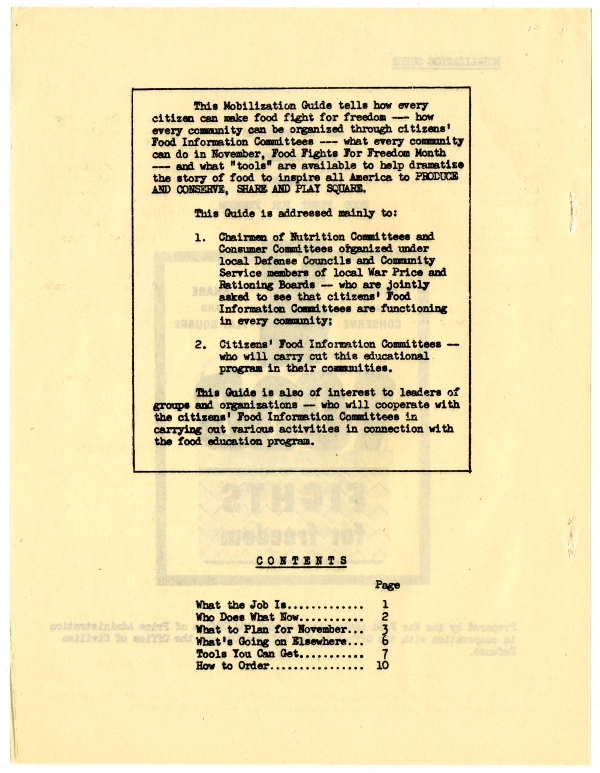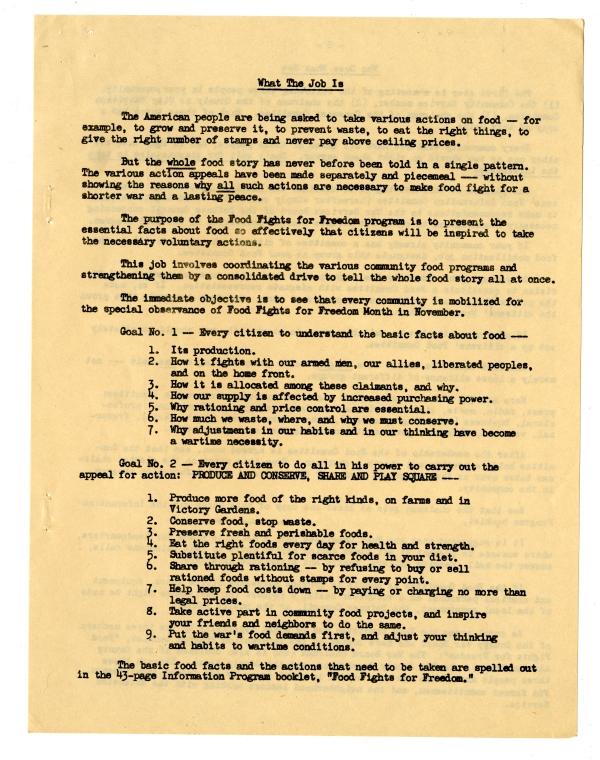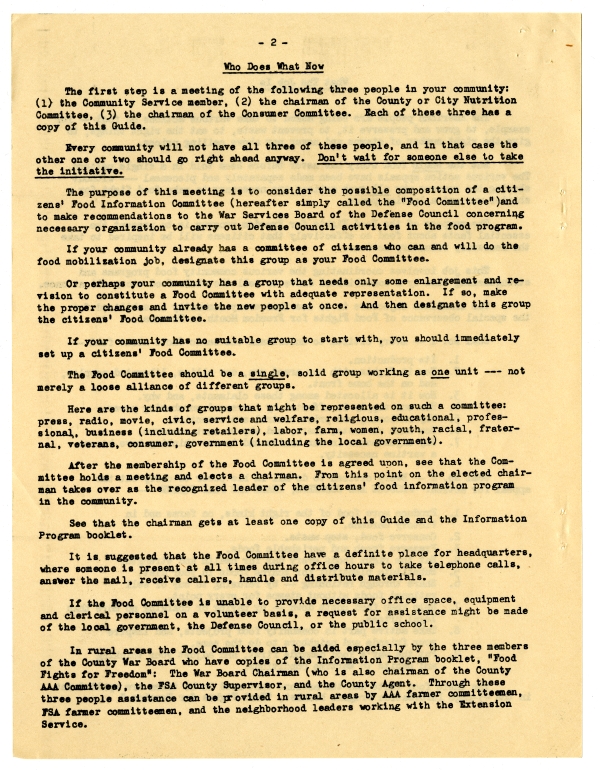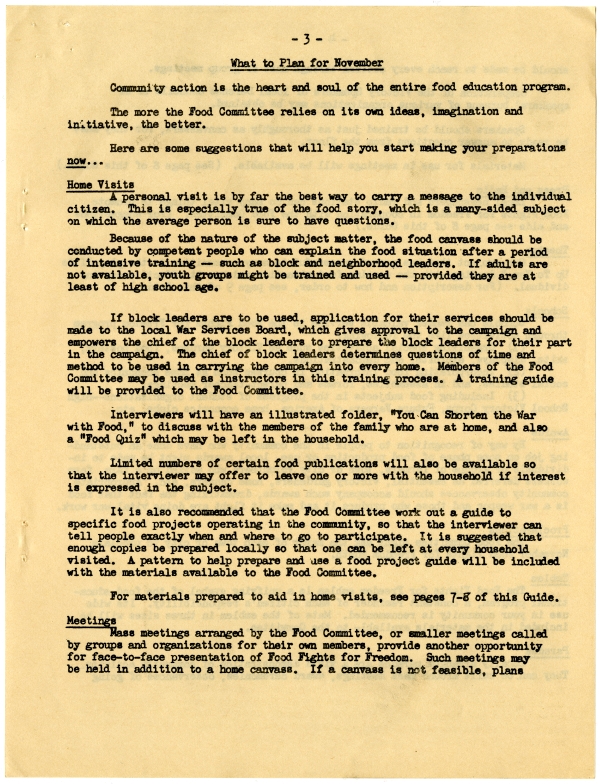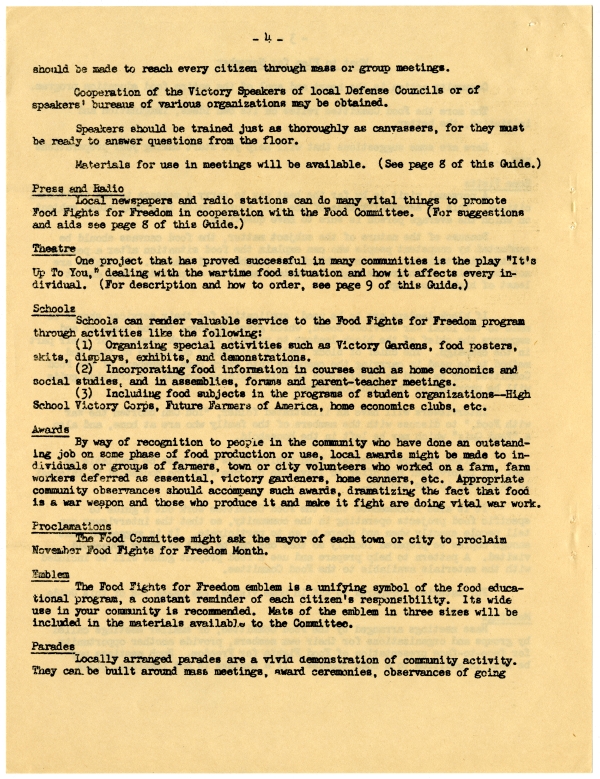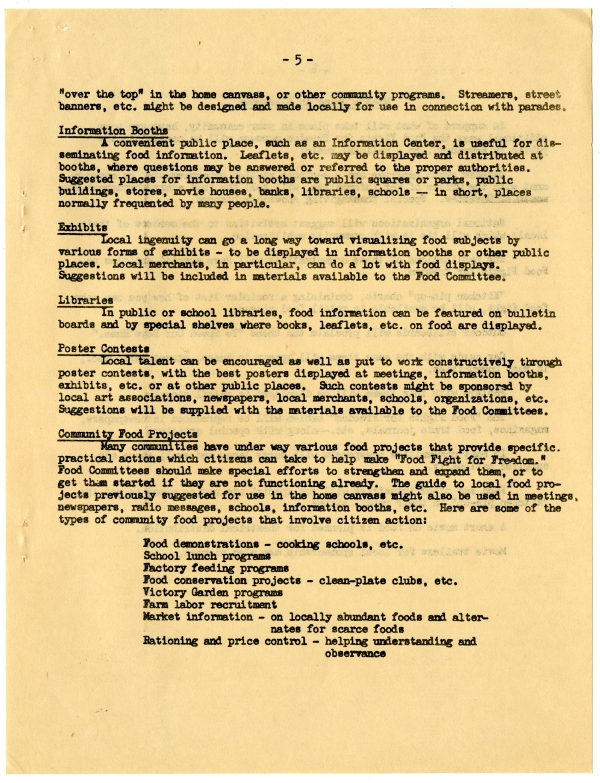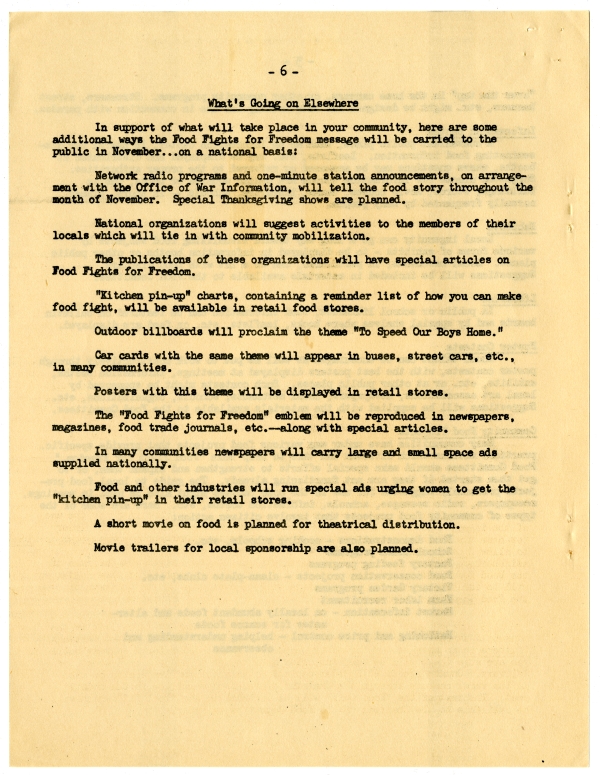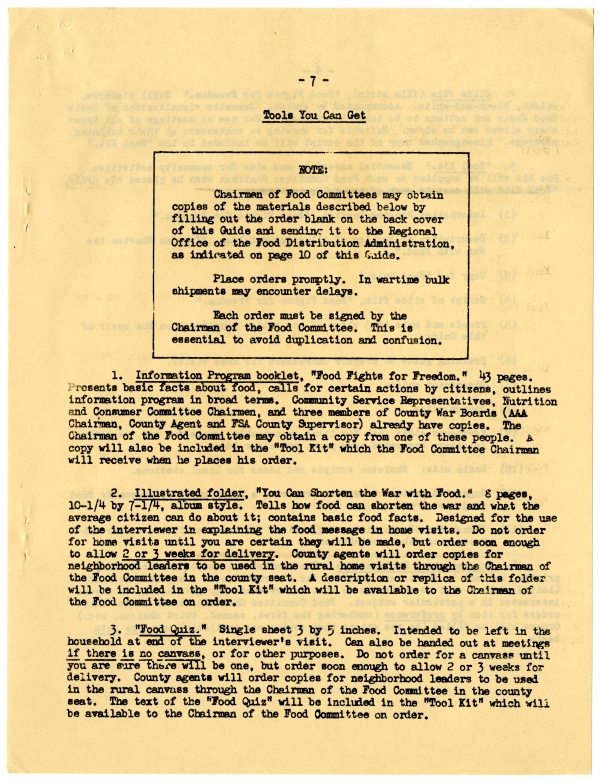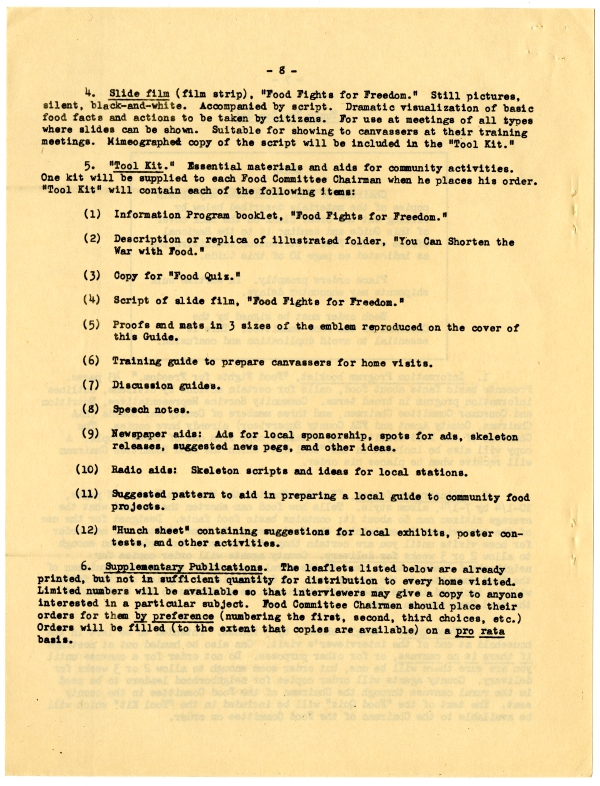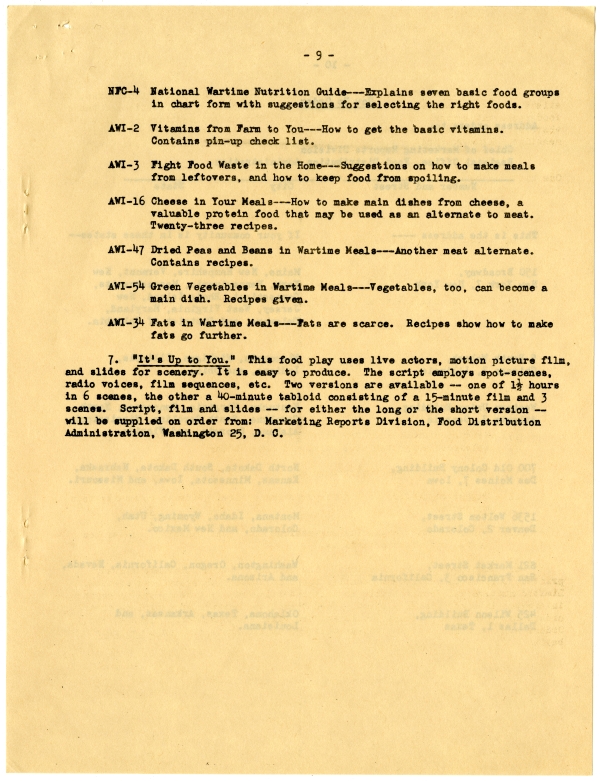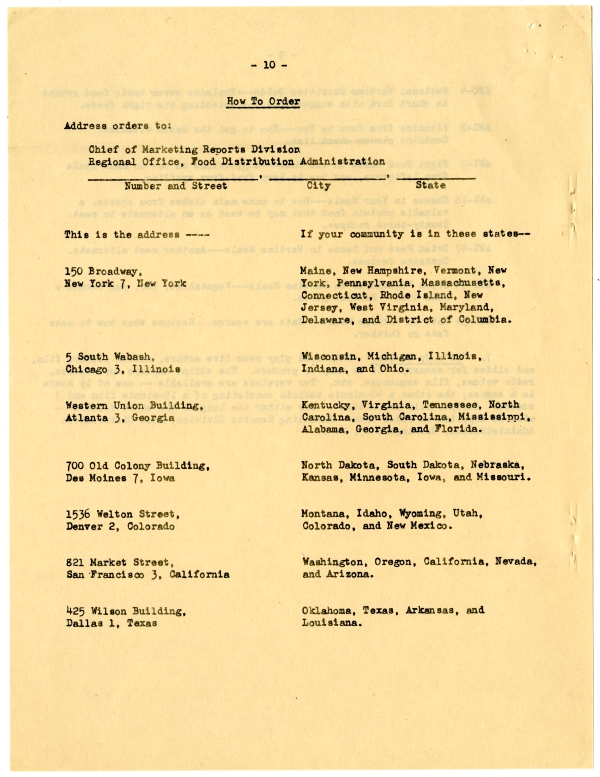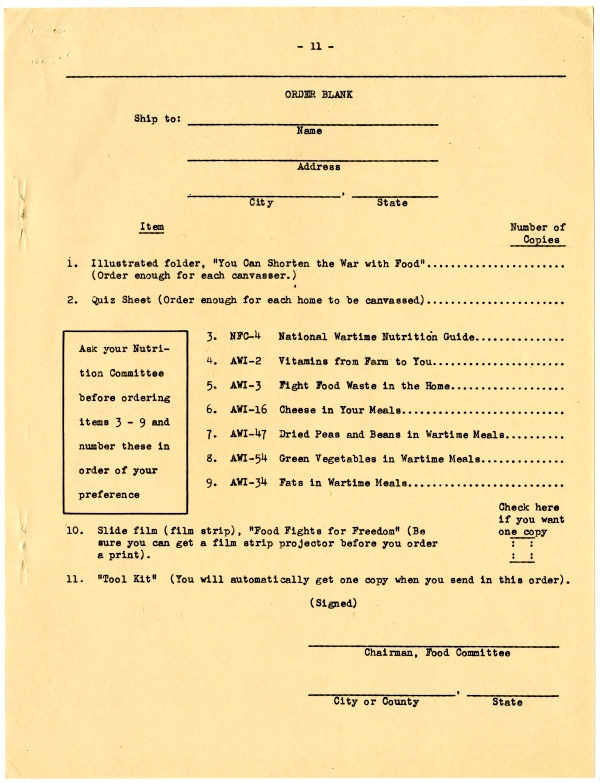Florida Memory is administered by the Florida Department of State, Division of Library and Information Services, Bureau of Archives and Records Management. The digitized records on Florida Memory come from the collections of the State Archives of Florida and the special collections of the State Library of Florida.

State Archives of Florida
- ArchivesFlorida.com
- State Archives Online Catalog
- ArchivesFlorida.com
- ArchivesFlorida.com
State Library of Florida
Related Sites
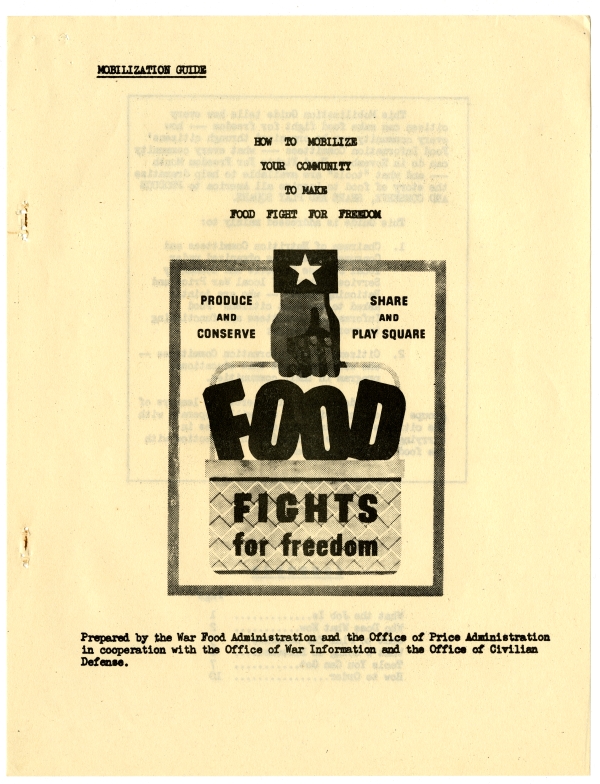
Description of previous item
Description of next item

Source
Description
Date
Format
Topic
HOW TO MOBILIZE YOUR COMMUNITY TO MAKE FOOD FIGHT FOR FREEDOM.
Produce and Conserve
Share and Play Square
Food Fights for freedom
Prepared by the War Food Administration and the Office of Price Administration in cooperation with the Office of War Information and the Office of Civilian Defense.
Title
Subject
Description
Source
Date
Contributor
Format
Language
Type
Identifier
Coverage
Thumbnail
Display Date
ImageID
topic
Subject - Corporate
Transcript
HOW TO MOBILIZE YOUR COMMUNITY TO MAKE FOOD FIGHT FOR FREEDOM.
Produce and Conserve
Share and Play Square
Food Fights for freedom
Prepared by the War Food Administration and the Office of Price Administration in cooperation with the Office of War Information and the Office of Civilian Defense.
This Mobilization Guide tells how every citizen can make food fight for freedom --- how every community can be organized through citizens’ Food Information Committees --- what every community can do in November, Food Fights For Freedom Month --- and what “tools” are available to help dramatize the story of food to inspire all America to PRODUCE AND CONSERVE, SHARE AND PLAY SQUARE.
This Guide is addressed mainly to:
1. Chairman of Nutrition Committees and Consumer Committees organized under local Defense Councils and Comity Service members of local War Price and Rationing Boards – who are jointly asked to see that citizens’ Food Information Committees are functioning in every community;
2. Citizens’ Food Information Committees – who will carry out this educational program in their communities. This Guide is also of interest to leaders of groups and organizations – who will cooperate with the citizens’ Food Information Committees in carrying out various activities in connection with the food education program.
CONTENTS
What the Job Is…….. 1
Who Does What Now…….. 2
What to Plan for November…….. 3
What’s Going on Elsewhere…….. 6
Tools You Can Get…….. 7
How to Order…….. 10
What The Job Is
The American people are being asked to take various actions on food – for example, to grow and preserve it, to prevent waste, to eat the right things, to give the right number of stamps and never pay above ceiling prices.
But the whole food story has never been told in a single pattern. The various action appeals have been made separately and piecemeal --- without showing the reasons why all such actions are necessary to make food fight for a shorter war and a lasting peace.
The purpose of the Food Fights for Freedom program is to present the essential facts about food so effectively that citizens will be inspired to take the necessary revolutionary actions.
This job involves coordinating the various community food programs and strengthening them by a consolidated drive to tell the whole food story all at once.
The immediate objectives is to see that every community is mobilized for the special observance of Food Fights for Freedom Month in November.
Goal No. 1 – Every citizen to understand the basic facts about food ---
1. Its production.
2. How it fights with our armed men, our allies, liberated peoples, and on the home front.
3. How it is allocated among these claimants, and why.
4. How our supply is affected by increased purchasing power.
5. Why rationing and price control are essential.
6. How much we waste, where, and why we must conserve.
7. Why adjustments in our habits and in our thinking have become a wartime necessity.
Goal No. 2 – Every citizen to do all in his power to carry out the appeal for action: PRODUCE AND CONSERVE, SHARE AND PLAY SQUARE ---
1. Produce more food of the right kinds, on farms and in Victory Gardens.
2. Conserve food, stop waste.
3. Preserve fresh and perishable foods.
4. Eat the right foods every day for health and strength.
5. Substitute plentiful for scarce foods in your diet.
6. Share through rationing – by refusing to buy or sell rationed foods without stamps for every point.
7. Help keep food costs down – by paying or charging no more than legal prices.
8. Take active part in community food projects, and inspire your friends and neighbors to do the same.
9. Put war’s food demands first, and adjust your thinking and habits to wartime conditions.
The basic food facts and the actions that need to be taken are spelled out in the 43-page Information Program booklet, “Food Fights for Freedom.”
- 2 -
Who Does What Now
The first step is a meeting of the following three people in your community: (1) the Community Service member, (2) the chairman of the Country or city nutrition Committee, (3) the chairman of the consumer committee. Each of these three has a copy of this Guide.
Every community will not have all three of these people, and in that case the other one or two should go right ahead anyway. Don’t wait for someone else to take the initiative.
The purpose of this meeting is to consider the possible composition of a citizens’ Food Information Committee (hereafter simply called the “Food Committee “)and to make recommendations to the War Services Board of the Defense Council concerning necessary organization to carry out the Defense Council activities in the food program.
If your community already has a committee of citizens who can and will do the food mobilization job, designate this group as your Food Committee.
Or perhaps your community has a group that needs only some enlargement and revision to constitute a Food Committee with adequate representation. If so, make the proper changes and invite new people at once. And then designate this group the citizens’ Food Committee.
The Food Committee should be a single, solid group working as one unit --- not merely a loose alliance of different groups.
Here are the kinds of groups that might be represented on such a committee: press, radio, movie, civic, service and welfare, religious, educational, professional, business (including retailers), labor, farm, women, youth, racial, fraternal, veterans, consumer, government (including local government).
After the membership of the Food Committee is agreed upon, see that the Committee holds a meeting and elects a chairman. From this point on the elected chairman tales over as the recognized leader of the citizens’ food information program in the community.
See that the chairman gets at least one copy of this Guide and the Information Program booklet.
It is suggested that the Food Committee have a definite place for headquarters, where someone is present at all times during office hours to take telephone calls, answer the mail, receive callers, handle and distribute materials.
If the Food Committee is unable to provide necessary office space, equipment and clerical personnel on a volunteer basis, a request for assistance might be made of the local government, the Defense council, or the public school.
In rural areas the Food Committee can be aided especially by the three members of the County War Board who have copies of the Information Program booklet, “Food Fights for Freedom”: The War Board Chairman (who is also chairman of the County AAA Committee), the FSA County Supervisor, and the County Agent. Through these three people assistance can be provided in rural areas by AAA farmer committeemen, FSA farmer committeemen, and the neighborhood leaders working with the Extension Service.
- 3 -
What to Plan for November
Community action is the heart and soul of the entire food education program.
The more the Food Committee relies on its own ideas, imagination and initiative, the better.
Here are some suggestions that will help you start making your preparations now …
Home Visits
A personal visit is by far the best way to carry a message to the individual citizen. This is especially true of the food story, which is a many-sided subject on which the average person is sure to have questions.
Because of the nature of the subject matter, the food canvas should be conducted by competent people who can explain the food situation after a period of intensive training – such as block and neighborhood leaders. If adults are not available, youth groups might be trained and used – provided they are at least of high school age.
If block leaders are to be used, application for their services should be made to the local War Services Board, which gives approval to the campaign and empowers the chief of the block leaders to prepare the block leaders for their part in the campaign. The chief of the block leaders determines questions of time and method to be used in carrying the campaign into every home. Members of the Food Committee may be used as instructors in this training process. A training guide will be provided to the Food Committee.
Interviewers will have an illustrated folder, “You Can Shorten the War with Food,” to discuss with the members of the family who are at home, and also a “Food Quiz” which may be left in the household.
Limited numbers of certain food publications will also be available so that the interviewer may offer to leave one or more with the household if interest is expressed in the subject.
It is also recommended that the Food Committee work out a guide to specific food projects operating in the community, so that the interviewer can tell people exactly when and where to go to participate. It is suggested that enough copies be prepared locally so that one can be left at every household visited. A pattern to help prepare and use a food project guide will be included with the materials available to the Food Committee.
For materials prepared to aid in home visits, see pages 7-8 of this Guide.
Meetings
Mass meetings arranged by the Food Committee, or smaller meetings called by groups and organizations for their own members, provide another opportunity for face-to-face presentation of Food Fights for Freedom. Such meetings may be held in addition to a home canvass. If a canvass is not feasible, plans
- 4 -
should be made to reach every citizen through mass or group meetings.
Cooperation of the Victory Speakers of local Defense Councils or of speakers’ bureaus of various organizations may be obtained.
Speakers should be trained just as thoroughly as canvassers, for they must be ready to answer questions from the floor.
Materials for use in meetings will be available. (See page 8 of this guide.)
Press and Radio
Local newspapers and radio stations can do many vital things to promote Food Fights for Freedom in cooperation with the Food Committee. (For suggestions and aids see page 8 of this Guide.)
Theatre
One project that has proved successful in many communities is the play “It’s Up To You,” dealing with the wartime food situation and how it affects every individual. (For description and how to order, see page 9 of this Guide.)
Schools
Schools can render valuable service to the Food Fights for Freedom program through activities like the following;
(1) Organizing special activities such as Victory Gardens, food posters, skits, displays, exhibits, and demonstrations.
(2) Incorporating food information in courses such as home economics and social studies, and in assemblies, forums and parent-teacher meetings.
(3) Including food subjects in the programs of student organizations – High School Victory Corps, Future Farmers of America, home economics clubs, etc.
Awards
By way of recognition to people in the community who have done an outstanding job on some phase of food production or use, local awards might be made to individuals or groups of farmers, town or city volunteers who worked on a farm, farm workers deferred as essential, victory gardeners, home canners, etc. Appropriate community observances should accompany such awards, dramatizing the fact that food is a war weapon and those who produce it and make it fight are doing vital war work.
Proclamations
The Food committee might ask the mayor of each town or city to proclaim November Food fights for Freedom Month.
Emblem
The Food Fights for Freedom emblem is a unifying symbol of the food education program, a constant reminder of each citizen’s responsibility. Its wide use in your community is recommended. Mats of the emblem in three sizes will be included in the materials available to the Committee.
Parades
Locally arranged parades are a vivid demonstration of community activity. They can be built around mass meetings, award ceremonies, observances of going
- 5 -
“over the top” in the home canvass, or other community programs. Streamers, street banners, etc. might be designed and made locally for use in connection with parades.
Information Booths
A convenient public place, such as an Information Center, is useful for disseminating food information. Leaflets, etc. may be displayed and distributed at booths, where questions may be answered or referred to the proper authorities. Suggested places for information booths are public squares or parks, public buildings, stores, movie houses, banks, libraries, schools – in short, places normally frequented by many people.
Exhibits
Local ingenuity can go a long way toward visualizing food subjects by various forms of exhibits – to be displayed in information booths or other public places. Local merchants, in particular, can do a lot with food displays, Suggestions will be included in materials available to the Food Committee.
Libraries
In public or school libraries, food information can be featured on bulletin boards and by special shelves where books, leaflets, etc. on food are displayed.
Poster Contests
Local talent can be encouraged as well as put to work constructively through poster contests, with the best posters displayed at meetings, information booths, exhibits, etc. or at other public places. Such contests might be sponsored by local art associations, newspapers, local merchants, schools, organizations, etc. Suggestions will be supplied with the materials available to the Food Committees.
Community Food Projects
Many communities have under way various food projects that provide specific practical actions which citizens can take to help make “Food Fight for Freedom.” Food Committees should make special efforts to strengthen and expand them, or to get them started if they are not functioning already. The guide to local food projects previously suggested for use in the home canvass might also be used in meetings, newspapers, radio messages, schools, information booths, etc. Here are some of the types of community food projects that involve citizen action:
Food demonstrations – cooking schools, etc.
School lunch programs
Factory feeding programs
Food conservation projects – clean-plate clubs, etc.
Victory Garden programs
Farm labor recruitment
Market information – on locally abundant foods and alternates for scarce foods
Rationing and price control – helping understanding and observance
- 9 -
NFC-4 National Wartime Nutrition Guide --- Explains seven basic food groups in chart form with suggestions for selecting the right foods.
AWI-2 Vitamins from Farm to You --- How to get the basic vitamins. Contains pin-up check list.
AWI-3 Fight Food Waste in the Home --- Suggestions on how to make meals from leftovers, and how to keep food from spoiling.
AWI-16 Cheese in Your Meals --- How to make main dishes from cheese, a valuable protein food that may be used as an alternate to meat. Twenty-three recipes.
AWI-47 Dried Peas and Beans in Wartime Meals --- Another meat alternate. Contains recipes.
AWI-54 Green vegetables in Wartime Meals --- Vegetables, too, can become a main dish. Recipes given.
AWI-34 Fats in Wartime Meals --- Fats are scarce. Recipes show how to make fats go further.
7. “It’s Up to You.” This food play uses live actors, motion picture film, and slides for scenery. It is easy to produce. The script employs spot-scenes, radio voices, film sequences, etc. Two versions are available – one of 1 ½ hours in 6 scenes, the other a 40-minute tabloid consisting of a 15-minute film and 3 scenes. Script, film and slides – for either the long or short version – will be supplied on order from: Marketing Reports Division, Food Distribution Administration, Washington 25, D.C.
Chicago Manual of Style
Food Fights for Freedom campaign - Mobilization Guide, ca. 1943. 1943 (circa). State Archives of Florida, Florida Memory. <https://www.floridamemory.com/items/show/299298>, accessed 13 December 2025.
MLA
Food Fights for Freedom campaign - Mobilization Guide, ca. 1943. 1943 (circa). State Archives of Florida, Florida Memory. Accessed 13 Dec. 2025.<https://www.floridamemory.com/items/show/299298>
AP Style Photo Citation

 Listen: The Blues Program
Listen: The Blues Program